Connecting Intentionally: The Beginning of Blights Out
A conversation between Rosemary Reyes and the core collaborators of Blights Out gives us an opportunity to reflect on the ways projects evolve and take shape.
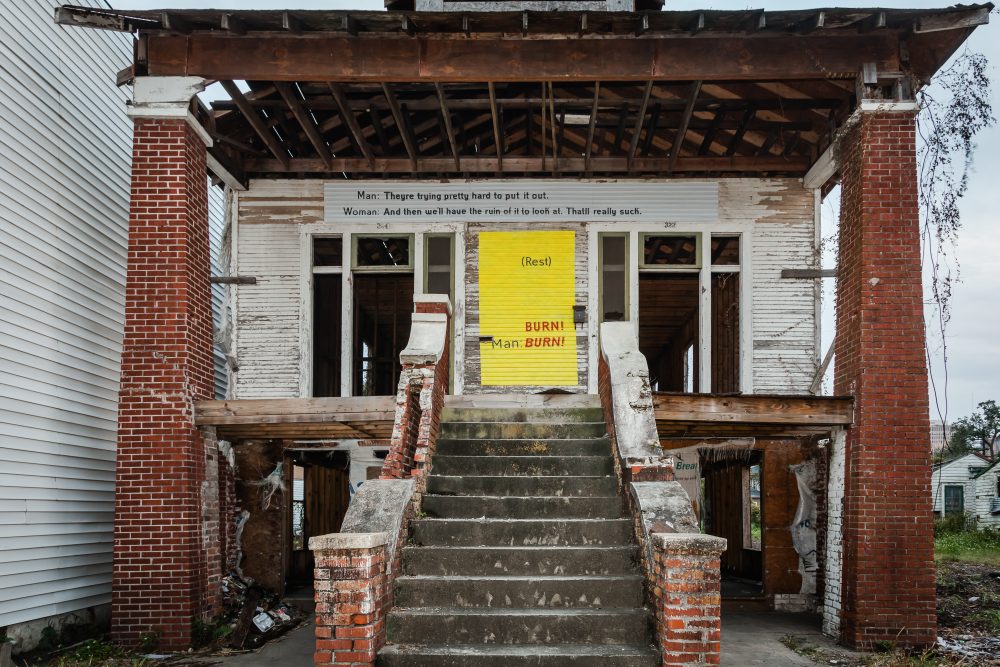
Blights Out began in 2014 during “Prospect.3: Notes for Now” with artist Lisa Sigal’s installations on houses in New Orleans’ Mid-City neighborhood. Courtesy the artist and Blights Out, New Orleans.
Editor's Note
I first met with New York-based artist Lisa Sigal, local artist Carl Joe Williams, and arts worker/activist Imani Jacqueline Brown in the fall of 2014, shortly after the inception of Blights Out during the citywide art exhibition “Prospect.3: Notes for Now.” A project that prioritizes transparency, interdisciplinary collaboration, community involvement, and creativity, Blights Out looks to ignite conversations around the rapid economic development in New Orleans by “performing architecture” and developing strategies to create permanently affordable housing.
In June 2015, I stopped by an unpublicized event where artists Katrina Andry, Ron Bechet, Amy Bryant, Jane Cassidy, Jer’Lisa Devezin, Keith Duncan, Horton Humble, and Varion Laurent were “live painting” portraits of houses in the project’s target neighborhoods of Mid-City and Tremé. I found the tension between long-term community residents and recent transplants very palpable. There was a curiosity about the pop-up event taking place on their shared streets, but the conversations I had with native artists there brought up a lot of issues haunting the black communities of New Orleans around the displacement of native bodies.
Since then, Blights Out—along with the National Organization of Minority Architects and Next City—co-hosted “Design As Protest,” an architectural workshop to explore ways to embed a restorative justice agenda into city planning and development. In advance of the tenth anniversary of Hurricane Katrina in August 2015, the initiative released a collective statement addressing place, belonging, and community in New Orleans.
Blights Out’s long-term goal is to purchase an abandoned structure and to transform it into a cultural resource center that is anchored to a community land trust, providing the local community with tools to access affordable housing in perpetuity.
Blights Out’s next program, Blights Out for President, looks to embed a citizen’s development platform into the electoral landscape through signage, public art, performance, and policy. Blights Out for President will launch during the national primaries in February 2016 and culminates with the November 2016 presidential election.
The conversation below took place in December 2014, just after Blights Out’s “Home Court Crawl,” a roving porch performance complete with a second line and music. Lines from Suzan-Lori Parks’ 365 Days/365 Plays were painted on blighted homes, and original performances of spoken word poetry addressed the previous abandonment of these homes and current gentrification of the city.
We discussed the driving forces behind Blights Out and how this activist arts initiative came to be. This discussion—from over a year ago—offers a moment to reflect on the ways an organization can develop as its community presence grows, as well as the pacing and process of ideas for collective action taking shape.
—Rosemary Reyes
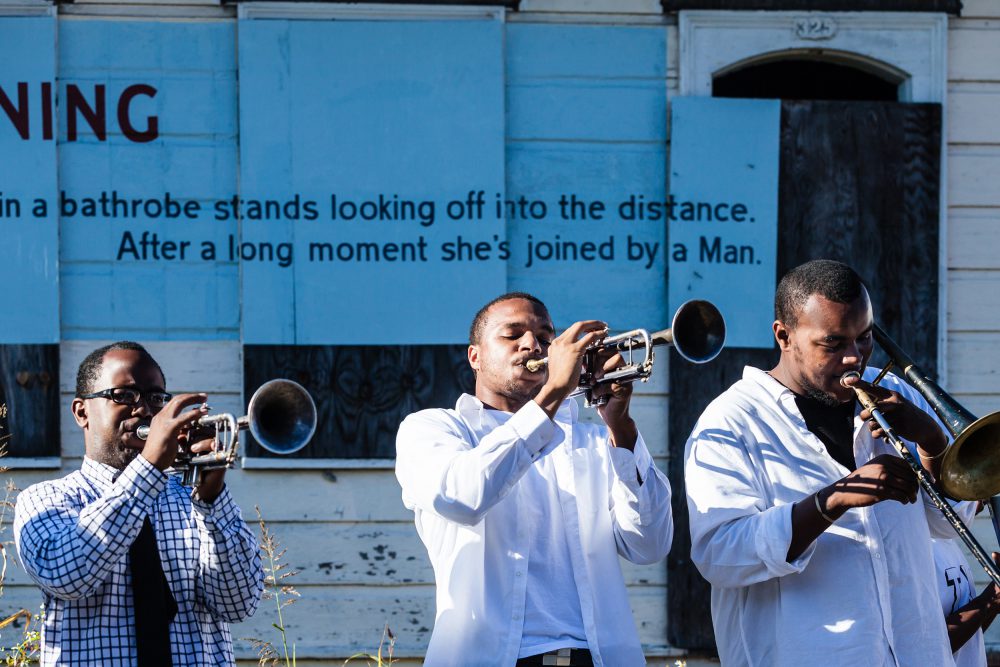
Blights Out and Frederick “Hollywood” Delahoussaye’s “Home Court Crawl,” December 2014. Photo by Scott McCrossen/FIVE65 Design. Courtesy Blights Out, New Orleans.
Rosemary Reyes: Lisa, I want to start with you, and talk about how your work has used abandoned spaces all over the world as a canvas, and how those experiences translated into Blights Out.
Lisa Sigal: My work responds to architecture as a code for the laws of a place, which brings racial inequalities and other societal inequities to the forefront. I am concerned with addressing these issues without aestheticizing them, which I feel would be unethical. When I was approached by Prospect to submit a proposal for the 2014 iteration, I came down to New Orleans for a week or two. I went around and painted on my easel in front of various housing projects that were being demolished and I would talk to the people who passed by. It was very performative. As a painter, the question is how to have a painting project that has a social component, which is a challenge—how to have a painting project that isn’t contained within the closed systems of the gallery and the market.
I wrote a Creative Capital grant in 2012 that was about envisioning architecture as silent protest. When I received the grant, Blights Out became a great way to enact those ideas. I was struck with thinking about the idea of a house as a page in a book. I had just read Suzan-Lori Parks’ 365 Days/365 Plays and I saw so many of those plays in the houses. She has this uncanny sense of the absurd as it relates to politics, people, and the cycles of history. I met with Parks and, when I suggested using 365 Days for Blights Out, she said, “take it girl.” I considered the range of plays and how they should vary from neighborhood to neighborhood.
Carl Joe Williams: Lisa sent me an idea of what she wanted to do. We decided to approach the New Orleans Redevelopment Authority with the project proposal and then Imani stepped in. The three of us began a discussion about all of the possibilities.
Imani Jacqueline Brown: I heard about the project in passing, but it stopped me in my tracks. I was like, “What? Wait, go back.” I’m very passionate about issues surrounding blight and housing. I’m from New Orleans and was displaced by Katrina. I evacuated and lived upstate for two weeks and then moved to the Washington, DC, area because my dad had always lived there. I never got any closure because I missed everything that my friends and family who came back had to struggle with.
I felt guilty in the way that guilt doesn’t always make sense; I was aching with it. I finished my last year of high school and then went to college in New York. Even though I had always planned on getting out of the South, it felt odd, like I was abandoning my people. Then Occupy Wall Street happened and I got involved. I learned that as a society we’re lacking opportunities to collaborate and learn from each person’s voice. Occupy opened up New York—a very tense, very sequestered city where everyone is alienated from each other. It gave people the opportunity to connect intentionally and to develop the tools to navigate difficult conversations. That was the most groundbreaking thing I’ve ever experienced in my life.
In 2012, Hurricane Sandy hit. There were areas in South Brooklyn, Queens, and New Jersey where entire sea walls were moved, and houses were decimated. And it was communities of color that suffered the most. I became involved in a grassroots hurricane relief effort that was open to anyone and all. One of the guiding principles was mutual aid rather than charity—empowering people and giving them the tools to pull themselves out. I worked on the relief effort all day, every day until I returned to my job. I was doing volunteer intake. I was in the kitchen. I was canvassing streets. Eventually, I went out to Far Rockaway, which is a working-class, majority-black community that is suffering from decades of divestment. It was a good moment for me to work through some of the guilt that I was feeling after leaving New Orleans, but it wasn’t my community. What does that mean? I didn’t live there, but I care about people. I care about the fact that disaster capitalists were literally waiting by the fences ready to buy up the houses with cash.
We were attempting to find ways of organizing and supporting the residents: teaching people how to do gutting and mold remediation but also doing it for them because they had so much other stuff to do and no one from the city or FEMA or the Red Cross was going to help.
There were also no community centers in all of Far Rockaway—no public spaces. There was just a parking lot where we would gather. So I started thinking with a few people: What if we could purchase one of the houses that had been previously vacant and build a center for healing? It couldn’t happen in New York; it wasn’t the time and place because real estate in New York is simply too expensive. Now getting this opportunity with Blights Out feels like there’s a cosmic energy around this project that has brought us all together.
LS: We meet the right people at the right time. It’s uncanny. Coming from New York, I also wanted to do that work, but can’t do it there. I’m coming to New Orleans as an outsider. I knew the only way that Blights Out could be a success is by learning together because none of us have a background in urban planning. It’s about making things accessible to each other and to all of the people that Imani and Carl have gathered around the project. But it’s a great combination of artists, activists, and cultural producers. We work well together and it feels natural.
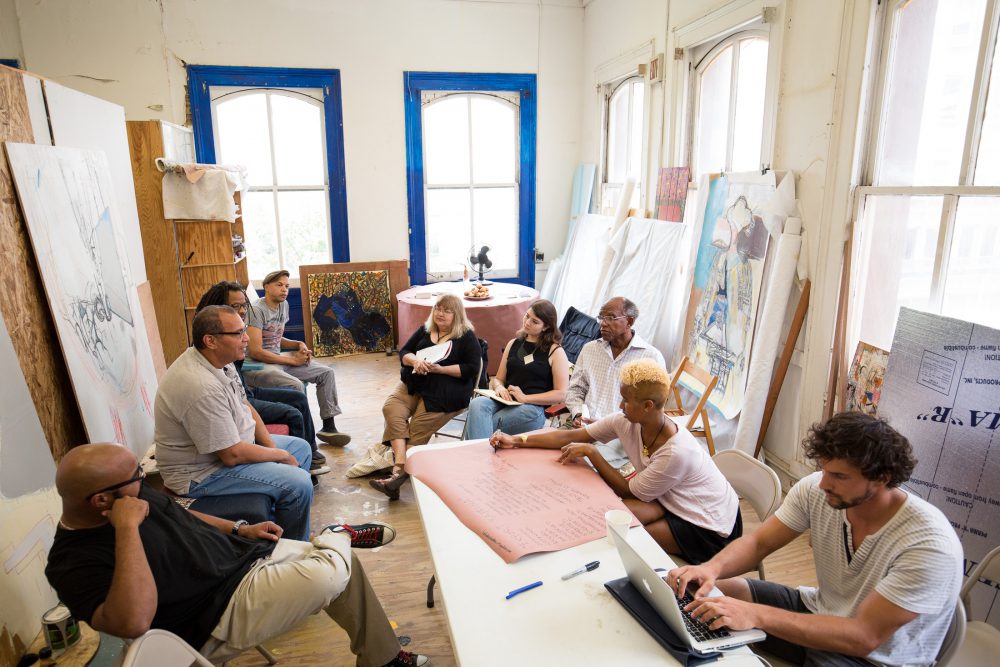
A Blights Out meeting on the eve of the tenth anniversary of Hurricane Katrina, August 2015. Photo by Bryan Tarnowski. Courtesy Blights Out, New Orleans.
RR: It seems that way. Imani, you mentioned your involvement with Occupy Wall Street. “Home Court Crawl” did feel like a political demonstration, but it was, ultimately, a celebration. It was a celebration honoring these homes that have been abandoned and neglected. People consider these homes to be derelict—eyesores. These negative connotations are attached to these buildings that are loaded with histories, like you’ve said, Lisa, “the laws of a place.” You’ve decided to personify these homes and make it into a performance.
LS: We courted Junebug Productions to organize the poetry performances for “Home Court Crawl” because they are in tune with a street theater dynamic that we want our project to be aligned with. Because Parks’ plays are fractured and somewhat abstract, the performances were a beautiful way to make the plays whole and to allow the performers to bring in their own voices, as well. It was very spontaneous. Frederick “Hollywood” (“Wood”) Delahoussaye wrote the piece he performed the morning of.
Imani and Carl have also been attending meetings organized by a coalition called Justice and Beyond. I think that was really important in making that connection to Junebug.
CJW: Justice and Beyond meets every Monday. It’s a group of concerned citizens, lawyers, and judges who get together to discuss issues and solutions. I started going with Imani and I was blown away. That’s how we were introduced to Sue Press. We were told to call her.
IJB: Sue is the leader of a Social Aid and Pleasure Club called Ole & Nu Style Fellas and their only female member.
LS: We went to Sue’s house for dinner and it was incredible. Junebug Productions facilitated a story circle.
CJW: “Wood” performed a spoken-word piece and we all shared what we felt at the time. People brought up some very significant stories and it was very moving.
IJB: “Wood”’s piece was a meditative moment of reflection on the complete abuse of black society.
RR: There’s abuse on every possible level. From where you live, how you live, and why you live to what you eat and when you eat. Every intimate level.
IJB: Right. It’s disrespect, mockery, insult. We know that this treatment isn’t new, but what is new is social media. Now everyone has a camera and a video recorder; we can document and see the way black people are treated. This forced reckoning is coming during one of our nation’s cyclical patterns of reorganizing how cities should function.
In the 1960s, the thought was let’s build an overpass at Claiborne Avenue. Now that the Tremé and the Ninth Ward are gentrified, it’s let’s take over every remaining neighborhood. And now that the black working class has been kicked out of the neighborhood, let’s consider demolishing the Claiborne overpass. It’s all absurd and everything is connected. That’s what we talked about at the dinner with Sue. Everything is intimately linked to violence against black people.
And that’s why New Orleans culture is the way it is. That’s why Social Aid and Pleasure Clubs came about. If the city is not going to protect us or insure us, then we’ll take care of it ourselves. We’re going to be proactive, think creatively and productively, and take to the streets.
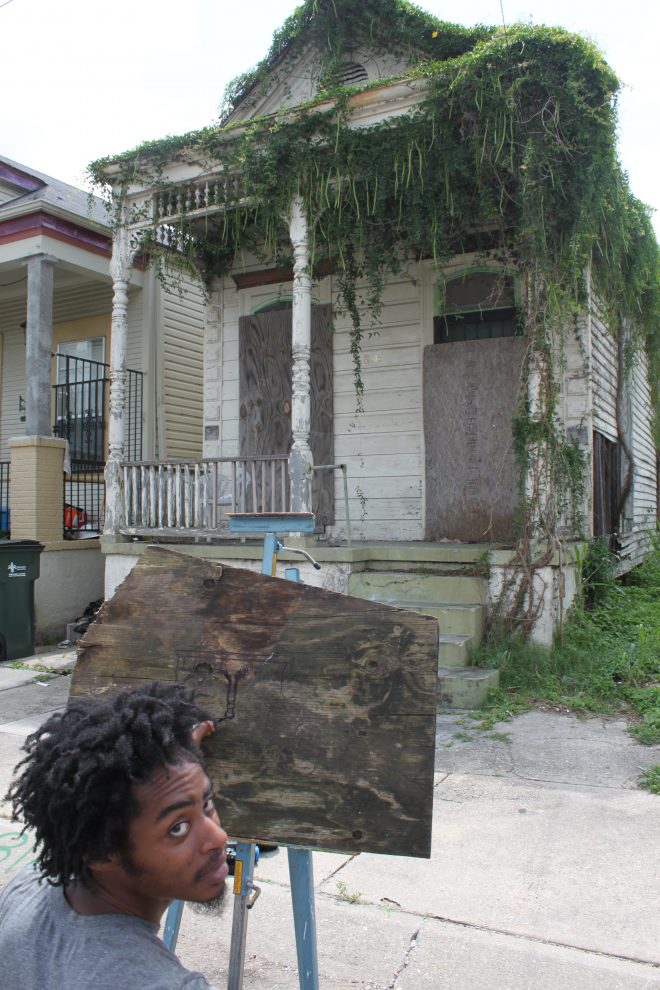
Craig Magraff at Blights Out’s “Live Action Painting” event in Tremé, June 2015. Photo by H. Hickman. Courtesy Blights Out, New Orleans.
RR: So what’s the next plan of action for Blights Out?
IJB: Well, that’s something we’re still thinking about because we recognize that we’re up against an immense force of encroaching development. The Tulane Medical Center has already changed the surrounding neighborhood drastically. We’re realizing that if we don’t home in on property fast for the project, we’re going to get priced out ourselves.
RR: I want to ask about the practical side of the project. Bringing attention to the problem on a creative and community level is wonderful, but what are the logistical struggles and additional implications of transforming blighted structures into community centers?
LS: The practical and ethical side of bringing resources into the community is complicated. It’s very hard to get funding for operation costs. We’re starting to talk about different fundraising models.
IJB: The next step for us is to establish working groups to identify properties. We need to do research on property law and title acquisition. There are lots of ways to acquire property and most of them are shady.
RR: Carl mentioned early involvement with NORA, which has a nefarious reputation. I’m curious to hear about that.
LS: We spent half of the summer writing a proposal for NORA because they said they were on board with helping us. They glanced at our application and agreed to partner with us. They handed us the listings for 250 properties and it seemed too good to be true because we wouldn’t have to scramble to get permission to obtain a property title. After a few weeks of their avoiding my calls, they turned to us with one potential property for donation.
IJB: I was skeptical, but it would have been interesting to work with a bureaucratic institution.
LS: We tried to go to the property auction. It was very cutthroat and they said they wouldn’t even consider donating a property for our cause.
RR: So they are contributing to the problem?
IJB: Yes, because NORA’s strategy is still market based.
CJW: Which is why they didn’t want to help us in the end. Our goals are the opposite of theirs.
IJB: It was a learning experience and we’re prioritizing transparency and accountability in the project. We want to translate this process of purchasing blighted property into something that people can understand and use themselves. So we’re also developing a toolkit for the public.
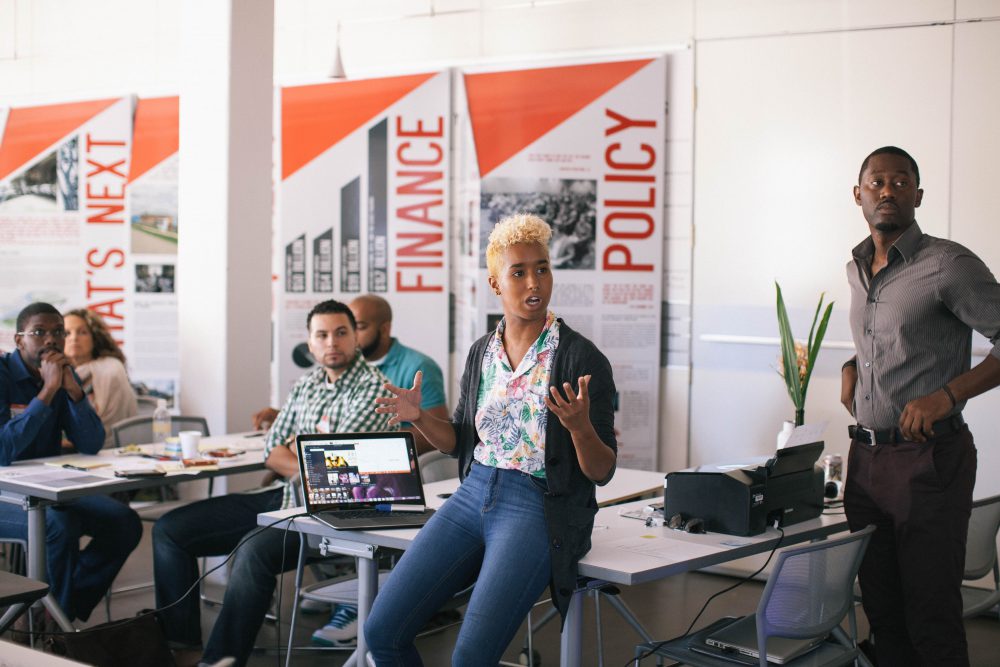
Blights Out, the National Organization of Minority Architects, and Next City’s “Design as Protest” workshop, October 2015. Photo by Patrick Melon. Courtesy Blights Out, New Orleans.
RR: What projects have inspired your work here?
LS: We’re looking at other projects here in New Orleans. We met with the Jane Place Neighborhood Initiative and we’re thinking about community land trusts as a way for residents to collectively invest in a neighborhood and to keep it affordable because land can be perpetually passed on to others and never rolled over to a developer. It’s a very good model.
IJB: What’s different about this project is we’re anchoring the community land trust idea in a creative process, which is collaborative and horizontal and rooted in connecting issues through art. In Chicago, there is Theaster Gates’ Dorchester Projects and in Houston there’s Project Row Houses. Blights Out isn’t an individual’s art project. We want to be open and community-oriented.
LS: We want to make it enjoyable, too, so that everyone can get involved and bring celebration and joy into the pain, absurdity, and ridiculousness of the conditions. It’ll be interesting to see how we can make all of this come together in a practical way, and how we can also use some alternative ways of going about it. We are artists after all, so this all just keeps unraveling and developing organically.



